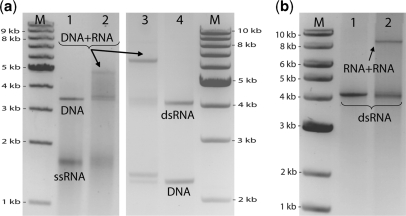Figure 3.
End-joining DNA to RNA and RNA to RNA. (a) Joining DNA to RNA. Lane 1 contains the result following our two step protocol without addition of STV, using a 3.5 kb DNA (A) molecule and a 4.2 kb ssRNA molecule (B). The ssRNA is seen to migrate at the approximately at the same speed as 1.5 kb DNA and –as expected- we see only bands corresponding to molecules A and B. In lane 2, where the protocol was followed in the presence of STV, a band appears at ∼5 kb DNA, corresponding to the A + B dimer. In lanes 3 and 4 we illustrate the same procedure with two different molecules: a 2.2 kb DNA molecule (A) and a 4.2 kb dsRNA molecule (B). Again, in the control experiment without STV no dimers are formed (lane 4). Conversely, in lane 3, after following our regular protocol in the presence of STV, an additional band is observed at ∼6.5 kb. As the bare dsRNA molecule migrates at ∼4.2 kb DNA, the band at 6.5 kb most likely corresponds to the A + B dimer. The efficiencies in both cases are similar to or even better than DNA–DNA binding shown in Figure 1. (b) Joining RNA to RNA. The same 4.2 kb dsRNA molecule used above was used with our protocol to create an 8.4 kb dsRNA molecule. Lane 1 contains the result following our two-step protocol without addition of STV, using the 4.2 kb RNA molecule as both A and B: no dimers are formed. However, in the presence of STV (lane 2) an additional band is formed at ∼8.5 kb DNA corresponding to the dsRNA–dsRNA dimer.

